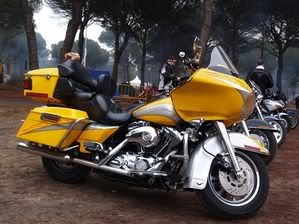Thursday, June 24, 2010
A look at some Of the different motorcycle engines.
Image source: Free Pictures of Spain
Motorcycles have been around for more than ten decades. During this time, motorcycle engines have developed through tweaking and reworking items to get the best performance. There have been more than one dozen engines, but some never met with success. Cost efficiency and customer satisfaction brought failure to a number of motorcycle engines.
All motorcycle engines are fueled by gasoline. To best understand engine types, it is important to understand how an engine works.
A pole called a rod cranks inside the engine and creates a draft that pulls both gasoline and air into a chamber called the cylinder. Inside the cylinder, a piston and rod quickly move up to push the gasoline and air into a smaller space where it meets the spark plug. The spark plug produces a spark between its two metal pieces.
Once the spark plug gives off a spark, the gasoline and air explode. This pushes the piston down, which in turn drives the belt or chain. This action is called torque. The movement of the belt or chain causes the rear wheel of the motorcycle to revolve. A motorcycle's performance is determined by how many cylinders are inside the engine and how they are arranged.
Single cylinder engine:
A single cylinder engine has one cylinder and one piston. Single cylinder engines are used in all off road motorcycles. The single cylinder provides a lot of torque, but also a load of vibration. The vibration is loud and one of the qualities that dirt bike race fans crave during a race.
Twin cylinder engine:
Logically, twin cylinder engines have two cylinders. The cylinders are placed together at an angle. Usually the cylinders are positioned at a 90 degree angle, but there are exclusions to that standard. A twin cylinder engine produces more power because there is more torque and more fuel used. Twin cylinder engines do not vibrate as much as a single cylinder engine.
Now, as stated above, there are exceptions. The boxed or boxer design finds cylinders placed side by side. This produces even less vibration, but adds a new issue. The cylinders tend to jut out the side of the bike, which makes it hard to take sharp corners. Another issue is the tremendous heat that the cylinders project; it makes leg protection a necessary evil.
Triple Cylinder Engines
A three cylinder engine finds the cylinders included in a head. This type of engine offers a load of power, but it also requires more parts. Each cylinder requires an additional fuel injector and carburetor. The more cylinders included on an engine, the higher the engine RPM. More RPM means more power. Triumph makes motorcycles using three cylinders and boy can they fly!
Four Cylinder Engines
The four cylinder engine is just like the three cylinder engine only it has the additional cylinder and therefore weighs more. As is true of any engine, more cylinders equal more power and smoother sailing.
It is important to consider how much size and power you require in your motorcycle. If you are taking your bike off road, you need a bike with plenty of torque and a low rpm to make it up hills and quickly navigate corners. For off roading, stick with a single cylinder. A double cylinder is your second choice.
If your main purpose for riding a motorcycle is riding through traffic and along roads, do not purchase a bike with less than a twin cylinder engine, although a three or four cylinder engine is a better idea.
Source: http://www.articlecircle.com


